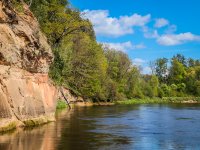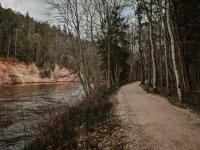
The last greatest rock wall of the Gauja valley, 15 m high. 8 m below water level, the Devil’s cave – an ancient place of worship – has formed in the cliff. It is a protected geological object.
| Address | Situated in the rocks of Devil’s cave, on the right bank of the River Gauja, approximately 2,5 km below Gauja bridge. |
| Coordinates | 57.149674 24.811865 |
| Phone | +371 67971335 |
| info@sigulda.lv |
The Devils Cave Rocks are the largest basset or outcrop in the Pikene cliffs; an almost 2 km large base of the Gauja valley's mainland. The exposed rock is 250M long and 15M high. It started to form about 10 thousand years ago during the Devonian period although its shape has been continuously changing ever since, often due to lateral erosion when big sandstone blocks separate and fall into the maelstrom (tidal whirlpool) of the Gauja. Today, this same place is a vertical rock with a maelstrom in its place. If you look closely, you can still see crisscrossed prints on the walls of the rock made by the torrents. Fish fossils, for example, the Placoderm fossil and some flora remnants of the Devonian Era, can be found in Devil’s Cave basset. It is actually the richest fossil place in the Sigulda area.
The Devil’s cave is located inside the rock, 8 m/7.5 ft above the Gauja River. This cave was formed by an underground spring, which has since vanished, and by the river’s erosion. The cave was actively formed about five thousand years ago. It is 35 m/115 ft deep.
Devil’s cave was once an ancient cult place for pagans. There are 6 holes on the cave’s ceiling known as the Devil's chimneys. A folktale recounts that the Devil, while flying from Jūdaži to Pabaži somewhere above the Gauja, heard a rooster crowing and chose this cave to hide in, sleeping in it until the next evening. Because of his breath, the walls of the cave were burned black. The following evening he escaped the cave only to run straight into Gauja's maelstrom. From time to time, while roaring and hissing, he pulls heedless visitors of the cave into the maelstrom.
In the 19th century, the cave was a popular tourist attraction and given the name „Taufelshöle” as mentioned in the magazine „Das Inland” in 1857. The number of guidebooks, postcards, and photos that show Devil’s Cave indicate its preference among tourists.
Since the pedestrian bridge was built over the Gauja River, the cave is only accessible from the opposite side of the river's coast. Before 1980, there was a narrow trail along the rock leading to the cave and also stairs and an artificial platform built 8m/7.5ft above the Gauja.
Please, remember that all caves are located in the territory of the Gauja National Park, and please respect the ancient geological nature monuments that keep the history of land formation!
























